Cookbook:Cookie
| Cookie | |
|---|---|
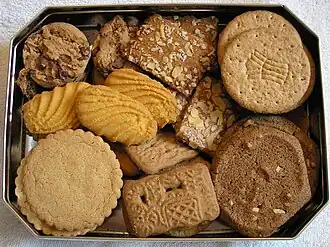 |
Cookbook | Recipes | Ingredients | Equipment | Techniques | Cookbook Disambiguation Pages | Ingredients
Cookies are a class of sweet baked good, overlapping somewhat with cakes and pastries. The term "cookie" is reported to derive from the Dutch for "little cake",[1][2][3][4] and it encompasses a wide variety of baked goods, including sweet biscuits in British English.[1][4] Savory biscuits as designated by British English are classified in the Cookbook as crackers.
Characteristics
It can be challenging to draw a precise line between all cookies and other sweet baked goods (e.g. cakes),[4][5] since the term is applied to a wide variety of small, sweet, baked morsels.[1][6] In general, cookies are small, flattened, and individually shaped,[1][2][4][7] baked free-form on a sheet and finishing with low moisture content.[4][8] They are usually eaten with the hands.
Beyond these similarities, cookies come in a wide range of sizes, textures, shapes, flavors, and more.[3][4] The ideal characteristics will depend both on the specific type of cookie and the preferences of the individual[4][9]—for example, some prefer chewy chocolate chip cookies while other prefer theirs crisp.
Composition
The primary components in cookie dough are typically some kind of sugar, fat, and flour, with the option of eggs and additional flavorings depending on the variety of cookie. All sugars, of course, contribute sweetness and browning to the cookie.[10][11] Granulated sugar helps incorporate air into cookie dough,[10] especially when creamed well with a solid fat or egg.[3] Granulated sugar also melts in the oven before recrystallizing upon cooling, thereby contributing a crispness to the finished cookie.[3][10] Liquid sugars like glucose syrup, honey, and molasses will not cause crystallization in this way, instead attracting water and causing softness.[3][9]
Flour in cookies is primarily structural,[11] though it can contribute to color—bleached, low-protein wheat flour brown less, for example.[9][12] High-protein and high-starch wheat flours (e.g. bread and cake flours, respectively) absorb more water and cause less spread than cookies made with pastry or all-purpose flours.[9][12][11] Pastry and all-purpose flours, however, are very commonly used.[2][11] Having a high ratio of flour to water yields dry, crumbly cookies without either gluten development or significant starch gelation.[11] A high ratio of water to flour allows for starch gelation but not gluten development, and the texture will be either cake-like or crisp.[11]
Fats contribute flavor, a feeling of moistness, and tenderness to cookies.[3][11] As lubricants, they disrupt the solid particles and contribute fluidity overall.[3][12] The higher the melting point and the less liquid the fat, the less spread will occur in the oven;[3][9][12] additionally, lower water content in the fat will also reduce spread compared to a pure fat.[3][9] Butter is more flavorful than shortening but will cause more spread.[9]
Chemical leaveners may be used in cookies, both for their leavening power and secondary effects. Baking soda, for example, neutralizes some of the acidity in the cookie dough, resulting in more spread and more browning.[9][12] Baking powder, on the other hand, will not significantly affect the acidity of the dough.[9]
The bulk of the water in cookie dough tends to come from egg, which also contributes protein for binding and a little fat from the yolk.[3] As a result of the moisture, eggs often contribute a puffiness and cakiness to cookies.[3][9]
Additional flavorings and mix-ins may be incorporated into cookies, such as dried fruits, nuts, seeds, chocolate, candies, and more.[2][11]
Spread
The spread of a cookie refers to how much the dough spreads out horizontally during baking, and a number of factors can contribute to increased spread. Spread occurs because as the dough heats up in the oven, it becomes more thin and fluid, coheres less well, and spreads out.[12] Eventually, with enough heat and time, the starches in the dough gelatinize and the proteins coagulate, which prevents any further spread of the dough.[12] A higher proportion of liquid in the dough evidently increases fluidity and spread.[6] A higher overall sugar content also has the effect of drawing more water into the fluid phase of the dough, making the dough more fluid and increasing spread.[12][6] Sugar also interferes with the gelatinization and coagulation, so the spread can proceed for longer before setting.[12] High-protein flour binds more water than does low-protein flour,[6] decreasing dough fluidity and therefore decreasing spread.[2][6] Adding starch to the dough achieves a similar effect.[2] Using fats with a lower melting point increases the dough fluidity and spread[6]—oil causes more spread than does butter,[12] which in turn causes more spread than does vegetable shortening.[6] Increasing the amount of air in the dough lowers its cohesive strength, thereby increasing spread; as a result, incorporating more air through extended creaming and additional leaveners will increase spread.[1][2][6] Leaveners that reduce the acidity of the dough (e.g. baking soda instead of baking powder) delay protein coagulation and setting of the dough.[12][6]

The baking environment will also influence spread. Greasing the baking surface decreases the friction between the dough and the surface, causing greater spread.[1][6] A lower oven temperature increases spread because it takes longer for the proteins and starches to heat up and set the dough.[2][9][6] Perhaps counterintuitively, however, chilling the dough actually reduces spread by making it take longer for the entire dough mass to warm through and become fluid; the crust can therefore form and set before much spread has a chance to occur.[9][6]

The following table summarizes factors that affect cookie spread.
| Decreased spread | Increased spread |
|---|---|
|
|
Texture
A variety of factors can contribute to a cookie's chewiness, including an overall high moisture content, a high ratio of sugar and liquid to fat, a high egg content, high-protein flour, and increased stirring to develop any gluten in the flour.[1][4][6] Soft cookies also require a high moisture content, but they have less sugar, and the sugars used may be particularly water-attracting (e.g. honey, glucose/corn syrup).[1][2][4][6] Conversely, the main cause of crispness in a cookie is very low moisture.[4] This can be achieved by simply including little moisture in the initial dough, using high sugar and fat proportions for pliability with the low moisture, baking for long enough to evaporate the moisture, and shaping the cookies thinly in order to more quickly achieve the latter.[1][2][4][6] Note that cookies will not be crispy while still warm; they must first cool down to achieve their snap.[10]
The following table links cookie texture with a variety of parameters involved in their creation:[2]
| Desired texture | Fat content | Sugar content | Sugar type | Liquid content | Four type | Shape |
|---|---|---|---|---|---|---|
| Crispy | High | High | Granulated | Low | Strong | Thin dough |
| Soft | Low | Low | Hygroscopic | High | Weak | Thick dough |
| Chewy | High | High | Hygroscopic | High | Strong | |
| High-spread | High | High | Coarse granulated | High | Weak |
Types
As mentioned, a huge variety of cookies exists, and these can be classified in a few ways.
By mixing method
Cookie dough mixing methods are very similar to those for cakes.[4] In the one-stage method, all ingredients are mixed together at once[13]—this works adequately if there is not a lot of risk of gluten development.[2][4] In creaming, the solid fat and sugar are beaten together before incorporating the flour and any liquids;[4][13] the degree of creaming will impact the aeration and spread as described above. With sanding, the flour and fat are rubbed together until crumbly or sandy before incorporating the moist ingredients.[4] Sponge/wafer/tuile cookie batters are made as with foaming, and the batter is delicate.[2][4]
By shaping
Drop cookies are formed from a soft dough portioned out in dollops onto the baking pan.[2][4][7][6] This is often done with portion scoops, spoons, or the hands;[3][6][13] the dough may also be rolled between the hands into a more compact ball before panning and baking.[2][13] Some doughs may need to be flattened slightly for optimal spread and shaping.[2][4][14] Classic chocolate chip cookies and oatmeal cookies are examples of this variety.[2][3][9][13] Doughs for drop cookies are often made by the creaming method.[9] These doughs can often be made into icebox cookies (see below).[2]
A similar variety of cookie is the piped, bagged, pressed, or spritz cookie,[2][13] which also uses a soft dough that is stiff enough to hold a shape.[4] Here, the dough is forced through a nozzle, either using a pastry bag or a specialty cookie press,[2][6][13] onto the prepared baking sheet. In general, this is done to create distinctive shapes and designs,[2][9][6] so the dough should not be one that will spread significantly.[9] Molded cookies are also formed into specific and sometimes intricate designs, using hands, stamps, or molds[4][6][14]—the dough here may need to be chilled or otherwise stiffened for ease of working.[2][14]
With so-called icebox cookies, the soft dough is shaped into a log and chilled in the refrigerator or freezer.[2][7][9] Once solidified, cookies are evenly sliced off the log for baking.[2][9][14] These cookies can be convenient, as the dough can be made and stored for some time before you are ready to bake the cookies.[2][4][6]
Breaking with the above styles, rolled-and-cut or cutout cookies are made by rolling a relatively stiff dough out in large sheets on a floured surface before cutting out individual cookies using knives or specialized cutters.[2][3][4][14][15] It's important to chill the dough sufficiently before rolling it out in order to avoid difficult handling.[6][15] Cookies should also be cut starting from the outside of the sheet and working towards the inside.[2] One downside to this style of cookie is that it tends to produce a lot of scraps—these can be pressed together and re-rolled, but the dough tends to get tougher as this continues, especially as more flour is incorporated.[2][4] If needed, the dough can be rolled out between sheets of parchment, plastic, or silicone.[2][4][14][15]
Bar cookies—not to be confused with sheet cookies (below), which are sometimes erroneously called bar cookies[4][6]—are made by baking a stiff dough in a large mass and then cutting into individual cookies while still warm.[4] Biscotti are one well-known example of this variety.[2][6]
Like bar cookies, sheet/pan cookies or traybakes are portioned after baking in sheets.[13][14] For this type, the dough or batter is pressed or spread in a shallow layer in the baking pan;[2] once baked, it is unmolded and cut into individual portion sizes.[2] Clean and even cuts can be more easily achieved by first chilling the baked mass by either refrigerating or freezing,[2][14] depending on the product. Some consider brownies as sheet cookies,[2][13] while others consider them cakes. Lemon bars, nut bars are other examples of preparations sometimes classified as sheet cookies.[3][6]
Wafer, tuile, tulipe, or stencil cookies are made with a thin dough or batter.[2][6][14] This batter is spread on silicone or parchment-lined pans, sometimes using a stencil cutout (hence the name),[2][4][9][6] before baking. Then, while still warm, the cookies can be trimmed or formed into a variety of shapes such as cups, rolls, cones, and more before cooling and setting.[2][9][6][14] This produces a thin, delicate, crisp cookie.[2][9][6] Due to their quick baking and complex handling, they should be prepared in small batches.[14]
Other
Sandwich cookies are, as the name implies, made by sandwiching a filling between two cookies. These include macarons, oreos, alfajores, linzer cookies, and more.
Selection and storage
Due to their high sugar content and low moisture content, cookies generally will not spoil at room temperature.[3] Depending on their storage conditions, however, they may go stale; crispy cookies will absorb moisture and become chewy,[1] while soft cookies will lose moisture and become hard.[3][4] The best way to store cookies is in an airtight container,[13] with a desiccant for crisp cookies and a moist item like an apple slice for soft cookies.[1][6] Unfrosted cookie dough and baked cookies also freeze well when protected from air.[2][9][15]
Use
Cookies are commonly served on their own as a snack or dessert.[2][15] However, they can also be used as ingredients in their own right, either as decor[2] or as an integral component of another dish. An example of the latter is the use of crisp cookies to make crumb crusts.
Techniques
Mixing
The mixing technique used when preparing the cookie dough will largely affect how the dough bakes and therefore the final texture of the cookie.[2] Creaming the butter before adding granulated sugar and not much afterwards will reduce the amount of incorporated air and reduce the puff and spread.[1][2] When making dense cookies that will hold their shape, you should avoid excessive or vigorous creaming and incorporation of air.[2][12] If a gluten-containing flour is used in a dough with a moderate amount of liquid, mixing should be kept to a minimum after the addition of the flour to prevent toughness.[2] It is also important to scrape down the mixing bowl when preparing the dough to ensure that all ingredients are properly distributed.[2]
Forming
Cookies should be formed according to their type and placed on a baking sheet prepared according to the recipe specifications.[14] The most important consideration when forming any variety of cookie is consistency.[4] Each cookie should be the same size, shape, and thickness to ensure proper and even baking across the entire sheet.[1][4] It is also important to space the cookies out enough that they will not touch each other when spreading in the oven,[2][6][15] and so that heat can circulate evenly.[2][13] The amount of space necessary will depend on the size and the cookie type. If adding garnishes before baking, these should be applied to the surface immediately after forming and pressed in gently to ensure they adhere properly to the dough.[2][4]
Baking and cooling
Most cookies are baked at a moderately high temperature for a short time to allow proper baking and coloration—somewhere from 8–14 minutes at 325–375°F (163–191°C) is common.[1][13][15] Doneness is often indicated by color,[4] though this can be difficult to ascertain in darker cookies such as those containing chocolate. If possible, take a peek at the undersides of the cookies, since these often cook faster than the top. If there is a risk of overcooking on the bottom relative to the rest of the cookies, double-layering the pans will help insulate the bottom from the heat.[1][2][4][14] Note as well that some carryover cooking will occur even after the cookies are removed from the oven.[2]
Often, cookies need to rest for a moment on the pans before moving to cooling racks, since many cookies are too soft to move while warm.[4][14] However, timely removal of cookies from unlined pans is often critical, since there is a risk of the cookies sticking to the pan once they set.[2][4] Excessive carryover cooking can also occur.[14] Cool cookies completely to room temperature before storage.[4][13]
Finishing
After baking, the cookies can be finished in a variety of ways.[2] Some are decorated, sandwiched, or filled with frosting, icing, chocolate, jam, fondant, marshmallow, and more.[1][2][4][8][14] In most cases, it's important to cool the cookies completely before decorating and finishing.[2][4] If storing the cookies by freezing, wait to finish them until you remove them from the freezer and return them to room temperature, since the decorations are often damaged in the freezer.[2][15]
Troubleshooting
The following table outlines some possible issues and causes that can arise when making cookies:[4]
| Problem | Potential cause |
|---|---|
| Too tough | Flour too strong |
| Too much flour | |
| Incorrect amount of sugar | |
| Not enough shortening | |
| Mixed too long or improper mixing | |
| Too crumbly | Improper mixing |
| Too much sugar | |
| Too much shortening | |
| Too much leavening | |
| Not enough eggs | |
| Too hard | Baked too long |
| Baking temperature too low | |
| Too much flour | |
| Flour too strong | |
| Not enough shortening | |
| Not enough liquid | |
| Too dry | Not enough liquid |
| Not enough shortening | |
| Baked too long | |
| Baking temperature too low | |
| Too much flour | |
| Not browned enough | Baking temperature too low |
| Underbaked | |
| Not enough sugar | |
| Too brown | Baking temperature too high |
| Baked too long | |
| Too much sugar | |
| Poor flavor | Poor-quality ingredients |
| Flavoring ingredients left out | |
| Dirty baking pans | |
| Ingredients improperly measured | |
| Sugary surface or crust | Improper mixing |
| Too much sugar | |
| Too much spread | Baking temperature too low |
| Not enough flour | |
| Too much sugar | |
| Too much leavening (chemical leaveners or creaming) | |
| Too much liquid | |
| Pans greased too heavily | |
| Not enough spread | Baking temperature too high |
| Too much flour or flour too strong | |
| Not enough sugar | |
| Not enough leavening | |
| Not enough liquid | |
| Insufficient pan grease | |
| Stick to pans | Pans improperly greased |
| Too much sugar | |
| Improper mixing |
Recipes
For cookies
Using cookies
Gallery
-
 Chocolate chip drop cookies
Chocolate chip drop cookies -
 Macarons
Macarons -
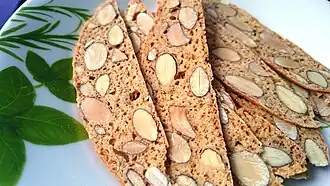 Biscotti
Biscotti -
 Alfajores
Alfajores -
.jpg) Pecan bars
Pecan bars -
 Gingersnaps
Gingersnaps -
 Fortune cookies
Fortune cookies -
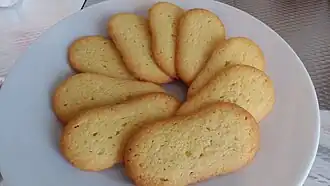 Langues de chat
Langues de chat -
 Tuile cookies shaped into cigars
Tuile cookies shaped into cigars -
 Macaroon
Macaroon -
 Animal crackers
Animal crackers -
.jpg) Black-and-white cookies
Black-and-white cookies -
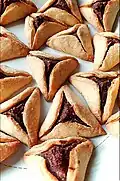 Hamantaschen
Hamantaschen -
.jpg) Russian teacakes
Russian teacakes -
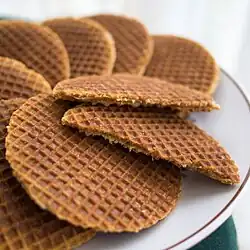 Stroopwafels
Stroopwafels
References
- ↑ a b c d e f g h i j k l m n o p Friberg, Bo (2016-09-13). The Professional Pastry Chef: Fundamentals of Baking and Pastry. Wiley. ISBN 978-0-470-46629-2.
- ↑ a b c d e f g h i j k l m n o p q r s t u v w x y z aa ab ac ad ae af ag ah ai aj ak al am an ao ap aq ar as at au av aw ax ay az ba bb bc bd Labensky, Sarah; Martel, Priscilla; Damme, Eddy Van (2015-01-06). On Baking: A Textbook of Baking and Pastry Fundamentals, Updated Edition. Pearson Education. ISBN 978-0-13-388675-7.
- ↑ a b c d e f g h i j k l m n o p q McGee, Harold (2007-03-20). On Food and Cooking: The Science and Lore of the Kitchen. Simon and Schuster. ISBN 978-1-4165-5637-4.
- ↑ a b c d e f g h i j k l m n o p q r s t u v w x y z aa ab ac ad ae af ag ah ai aj ak al am Gisslen, Wayne (2016-09-21). Professional Baking. John Wiley & Sons. ISBN 978-1-119-14844-9.
- ↑ "Understanding the Science of Cookies | Institute of Culinary Education". www.ice.edu. Retrieved 2025-01-01.
- ↑ a b c d e f g h i j k l m n o p q r s t u v w x y z aa ab ac ad ae Rinsky, Glenn; Rinsky, Laura Halpin (2008-02-28). The Pastry Chef's Companion: A Comprehensive Resource Guide for the Baking and Pastry Professional. John Wiley & Sons. ISBN 978-0-470-00955-0.
- ↑ a b c Davidson, Alan (2014-01-01). Jaine, Tom (ed.). The Oxford Companion to Food. Oxford University Press. doi:10.1093/acref/9780199677337.001.0001. ISBN 978-0-19-967733-7.
- ↑ a b Manley, Duncan (2011-09-28). Manley’s Technology of Biscuits, Crackers and Cookies. Elsevier. ISBN 978-0-85709-364-6.
- ↑ a b c d e f g h i j k l m n o p q r s t u v Amendola, Joseph; Rees, Nicole (2003-01-03). Understanding Baking: The Art and Science of Baking. Wiley. ISBN 978-0-471-44418-3.
- ↑ a b c d "Cookie science: How to achieve your perfect chocolate chip cookie | King Arthur Baking". www.kingarthurbaking.com. Retrieved 2025-07-25.
- ↑ a b c d e f g h Ruhlman, Michael (2008). The Elements of Cooking: Translating the Chef's Craft for Every Kitchen. Black Incorporated. ISBN 978-1-86395-143-2.
- ↑ a b c d e f g h i j k l Figoni, Paula (2010-11-09). How Baking Works: Exploring the Fundamentals of Baking Science. John Wiley & Sons. ISBN 978-0-470-39267-6.
- ↑ a b c d e f g h i j k l m Goldstein, Darra (2015-01-01). The Oxford Companion to Sugar and Sweets. Oxford University Press. doi:10.1093/acref/9780199313396.001.0001. ISBN 978-0-19-931339-6.
- ↑ a b c d e f g h i j k l m n o p The Culinary Institute of America (CIA) (2015-02-25). Baking and Pastry: Mastering the Art and Craft. John Wiley & Sons. ISBN 978-0-470-92865-3.
- ↑ a b c d e f g h The Culinary Institute of America (CIA) (2011-09-13). The Professional Chef. John Wiley & Sons. ISBN 978-0-470-42135-2.